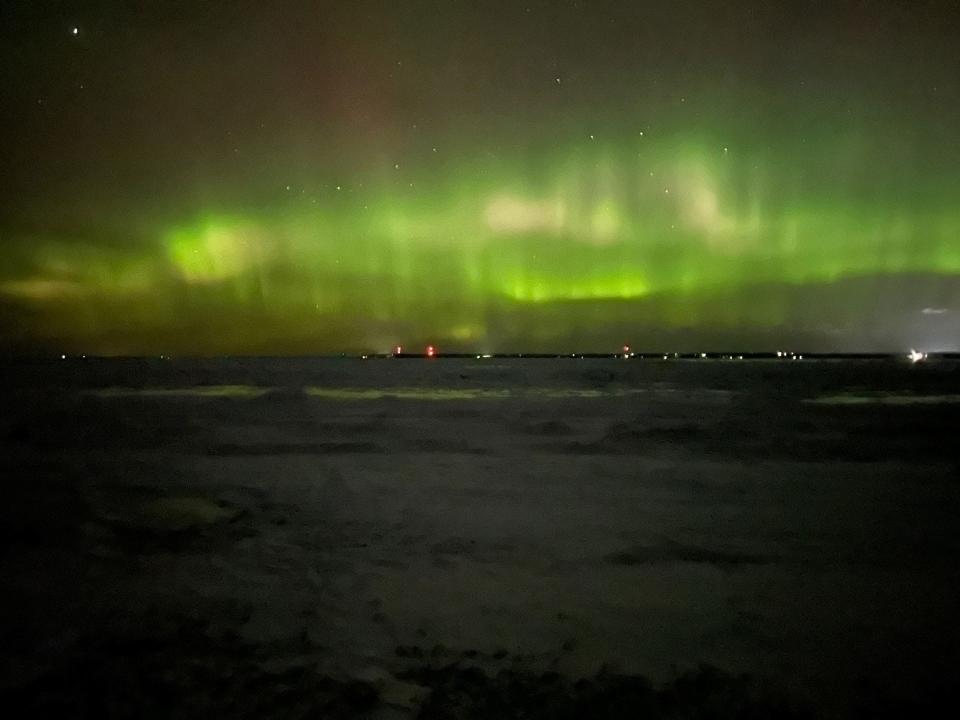Northern lights possible in Michigan on Thursday: Forecast, where you might see them, more
Northern Michigan may catch a glimpse of the northern lights this week, though the chances are low. Low solar activity and cloud cover in local skies could dampen the prospects of watching the aurora for Michiganders.
Let's take a look at what the auroras represent and how to prepare for a look at the natural lights display.
How auroras form
The northern lights, or aurora borealis, represent waves of light from solar wind, creating a display of moving lights in the night sky. The natural phenomenon generates great public interest with its varied display of colors and shapes of light. Auroras typically form heights ranging from about 50 to 75 miles, though they can reach heights of up to 620 miles. The lights appear in a range of colors, including greens, pinks and reds, often featuring several shades of these colors.

When they occur
Auroras occur throughout the year and at various times of day. For those in the northern hemisphere, plan for viewing the lights at nighttime, in dark, clear conditions. The lights take on many different shades and appear to dance across the sky, creating a colorful backdrop to the star-filled nights. Visibility can change based on weather and atmospheric conditions, making the predictability of the northern lights uncertain.
Auroras are impacted by the solar cycle, as scientists monitor conditions around the 27-day period of the sun's rotation. With solar conditions and weather on Earth being so variable, aurora predictions can change significantly during this period, said Rob Steenburgh, acting operations chief at the Space Weather Prediction Center.
Where to view the lights
Auroras often appear in the northern and southern hemispheres, but stronger solar activity brings them closer to the equator. This gives people in parts of the northern U.S., including Michigan, a chance to see the lights.
Northern Michigan currently has a low chance of getting to see the aurora this week. That's based on the solar forecast showing a minor solar storm for Thusday, Steenburgh said. If the predicted solar storm becomes stronger, there will be a greater chance of the northern lights being visible in northern Michigan. This would occur if a more intense solar storm pushed the auroras farther south toward the U.S.
Solar activity warning
Solar maximums, an increased period of solar activity in the solar cycle, pose a risk to human activity in space and on earth. The phenomenon consists of high appearances of sun spots and solar storms. The solar activity could harm technology services on earth, including communication systems. Experts warn this period could come sooner than typical, continuing to monitor the solar cycle.
Northern lights history
In recent years, the northern lights have appeared across Michigan skies several times, including this spring. The northern lights also typically feature prominently across parts of Alaska, Canada and other northern U.S. states.
People have been observing the aurora borealis for thousands of years, forming an integral part of several cultures, according to the Library of Congress. The term aurora borealis dates to the early 15th century, Latin for the Roman goddess of dawn Aurora. Over the centuries, advances in modern technology and science have broadened humans' understanding of the lights and why they occur, adding meaning to the popular light show.
More: Bipartisan bill would allow Canadian snowbirds to extend stay in US by 2 months
Weather outlook
Getting the best view of the northern lights also depends on viewing conditions affected by weather on Earth. The ideal setting depends on the day's weather, as viewers need a clear sky to observe the auroras.
Northern Michigan should see a clearing of cloud cover and dry conditions overnight Thursday, the National Weather Service said. The region will have partly cloudy skies with temperatures in the mid- to high 60s.
This article originally appeared on Detroit Free Press: Northern lights in Michigan forecast: Where you might see them

